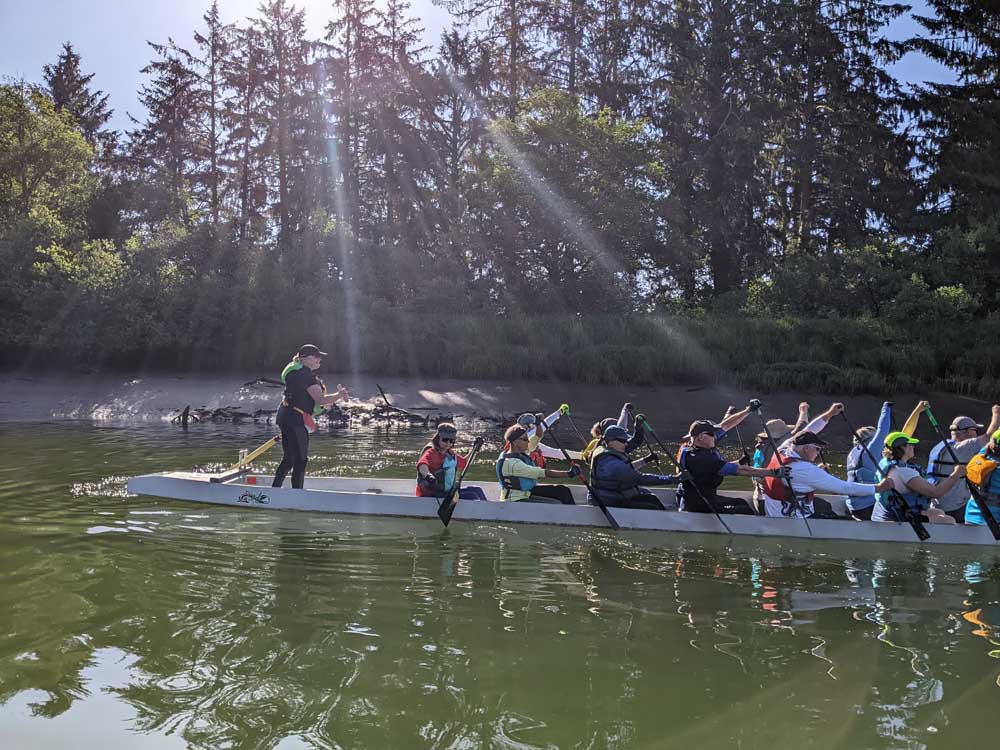Paddlers launch a local dragon boat club
Published 10:00 am Friday, September 1, 2023

- The Tide Runners run through a morning practice on the Nehalem River.
NEHALEM — Suddenly, there’s a fish in the boat, flopping around in the hull after a leap from the Nehalem River. The women pause, paddles raised, and wonder: Is it a good luck sign?
Sure, why not, says their coach, Char vonAhlefeld, from her seat at the head of the boat.
Their boat is long, canoe-like, a dragon boat. The women sit in pairs on benches. They are little more than a hand’s length above the water, nearly hip to hip, knees close to the backs of the women in front of them. Close quarters. But they quickly grab this small, wriggling good luck charm and drop it back into the river.
Then they’re off, driving their short paddles into the water and pulling back. Each woman keeps her eye on the paddling arm of the woman in front of her.
After a warmup that takes them farther out onto the Nehalem, vonAhlefeld starts beating a small drum.
The women strain, their paddles rising and falling faster and faster in time with the drumming. The boat lunges forward. They have hit racing speed. There are the sounds of the drum and paddles slicing into water, but above all of that: the sharp, rhythmic breathing of 24 women working as hard as they can.
“Come on!” vonAhlefeld yells. “Keep going!”
Then — as their breathing becomes a pant — “Let it ride!”
The paddles rise out of the water together. Some women cheer. Others laugh as they groan and lean forward to catch their breaths.
There is nothing, they’ll say later, quite like paddling a dragon boat together.
Dragon boat racing is believed to have originated in China several thousand years ago. The modern-day version began in the 1970s. The boats are powered entirely by paddlers, who sit in pairs on benches. A caller or coach sits at the front of the boat and uses drum beats and vocal commands to direct the paddlers. At the back of the boat, a steer person keeps the boat on course. Races occur all over the world.
The Nehalem Tide Runners, a satellite division of the Portland-based Wasabi Paddling Club, has existed for more than a decade and boasts around 40 members. It includes an all-ages women’s team that has competed in dragon boat races both locally and internationally.
Now two of those members want to bring dragon boats to Clatsop County.
Sande Brown, a retired administrator with the Seaside School District, and Sheila Roley, a retired former superintendent for the Seaside School District, regularly make the hourlong drive from their homes in Astoria to practice with their fellow paddlers in Nehalem. It can be a trek.
The Tide Runners club draws people from across southern Clatsop County and northern Tillamook County. Roley and Brown are certain demand would be equally strong in the northern part of Clatsop County if there were a closer option.
Together they have formed a nonprofit — the North Coast Paddling Club — and have identified a 10-person dragon boat for purchase. They are ready to begin fundraising and applying for grants — the boat itself will cost around $4,000 — and recruiting paddlers. All they are lacking is a place to dock a boat.
It’s a chicken-and-egg kind of dilemma. Until they have a place to call home, they can’t do the work to build up the other components of a paddling club, but if they don’t have those other components in motion, it might be hard to convince someone to give them space at a dock.
Dragon boats are too big and heavy to be easily moved in and out of the water for frequent practice sessions, so the North Coast Paddling Club needs a place where a boat could be left year-round. They also need a place where water conditions are ideal for safe paddling.
The Columbia River and the channel that is key for shipping moves too fast for what dragon boat paddlers want to handle. So Brown and Roley are looking at nearby Youngs River, the Youngs River Bay, John Day and the Lewis and Clark River.
They spoke with county administrators about using public docks, but they wouldn’t be able to store the dragon boat there. Brown has a spreadsheet of other people to contact and places to investigate as possible options, but has so far come up short.
Both women believe a local team would be a big contribution to the community — and, Brown thinks, the annual Astoria Regatta celebrations — and would make the sport more available to people who don’t have the time or ability to drive down to Nehalem.
While intense, paddling a dragon boat is accessible across ages, they say. Most of the women who race for Tide Runners are older, but range in age from their 20s to one paddler who is in her 80s.
“It’s really a sport for everyone, and I think that’s not always the case with team sports,” Roley said.
With many team sports, you might need a specific type of physical skill. “And certainly there’s skill with dragon boating,” she added. “But it’s a skill that, with some hard work, anyone of any age really can acquire.”
And it is a peaceful experience. When you step onto a dragon boat, Brown and Roley say one of the first things you will notice is how quiet it is.
“When I get on the water, I don’t think about work, I don’t think about what’s for dinner or any of my other responsibilities in life,” Roley said. “I just push off, and the only thing I think about is just being on the water, doing my part to move the boat forward.”





